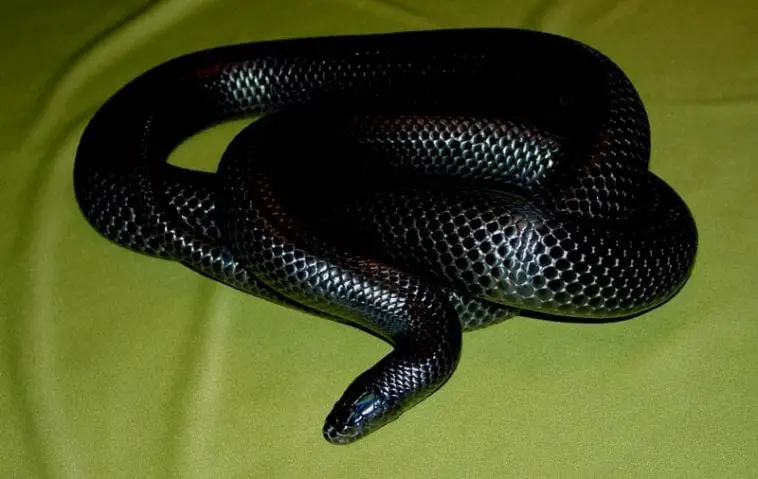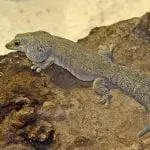Scientific Facts
| Common Name | Black Milk Snake |
| Scientific Name | Lampropeltis Triangulum Gaigeae |
| Life Span | 10 to 12 years |
| Length | About 84 inches |
| Clutch Size | 8 to 10 eggs |
| Habitat | Panama, Costa Rica |
Physical Description
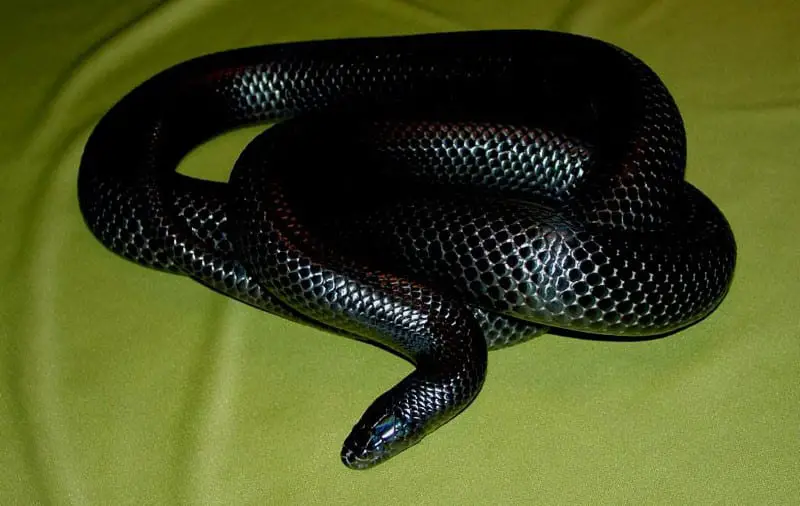
Black Milk Snakes usually start off as huge, tricolored hatchlings. They feature a red base color, a black tip on scales, along with some bands of black and white). As hatchlings, they are usually about 12 inches or more in length. Some hatchlings are even observed to grow as long as 16 inches out of their eggs.
They are capable of eating baby rodents right from the start. They continue to grow gradually, reaching as long as 7 feet eventually at around 4 or 5 years of age. They are also described as beefy snakes. They usually weigh about 3 to 3.5 pounds. It has been believed that these snakes eat anything that they can overpower in the wild, including lizards, rodents, small birds, as well as other snakes.
Information About Black Milk Snakes
Black Milk Snakes have gained popularity amongst the colubrid enthusiasts, even attracting the attention of new hobbyists. They possess all the features that are loved and adored by reptile lovers. They are easy to take care of, easy on the eyes, and with an easygoing personality.
Even though many may turn their eyes away from the appearance of an all-black snake, the reality is, not many people may have actually seen a black milk snake in the flesh. The muscular body and iridescence of these snakes are among the features that make them attractive up close.
Even though Black Milk Snakes were priced higher in the mid-1990, the price has fallen steadily as more and more breeders have become attracted to this mild-mannered reptile. Hatchlings can now be availed of from online sources, directly from breeders. Aside from their natural beauty and allure, these black milk snakes feature a mysterious appeal that makes them more interesting.
Black Milk Snakes got their name from a folktale, describing how a snake snuck into a barn and drank milk from nursing cows. However, this tale is not proven to bear in reality as it is impossible scientifically. For one, snakes do not have lips and could not suck. Also, the cows will surely not allow them and might even run away after seeing snakes.
Taxonomy and Etymology
The genus of the species, “Lampropeltis,” is a Greek word that means “shiny shields.” This is a good description for Black Milk Snakes, as they are known for their glossy and prominent scales. The main species, the Milk Snakes, have 24 subspecies which are recognized currently in the pet trade.
Black Milk Snakes vs. Venomous Snakes
Black Milk Snakes have the reputation of using mimicry as part of their strategy for defense. For this reason, they are usually confused with coral snakes and copperheads because they also have bright and blotchy color. These snakes evolved to look like their venomous counterparts to scare off predators. While this can prove to be a good thing for black milk snakes, it can also be harmful to them, as humans often kill them, thinking that they are dangerous.
One way to recognize them is by paying close attention to the actual shape of their blotches. The bands of milk snakes are thick and rounded, while the splotches on copperheads usually have a distinct hourglass shape.
Some colors of milk snakes are also similar to those of coral snakes. The latter usually have alternating color bands, though the pattern still differs. Coral snakes usually have yellow and red bands next to each other, while the nonvenomous milk snakes have black and red bands.
To protect themselves, black milk snakes attempt to trick their predators into thinking that they are rattlesnakes. They do so by shaking their tails. Still, this can result in some problems when humans view them as dangerous. The appearance might be different, but the behavior of rattling their tail can easily confuse humans.
Range
Black Milk Snakes come from Central America. They are mainly found in the high-altitude cloud forests of Costa Rica and Panama. Even though they are not considered as aquatic species of snakes, they live in wet and cloudy microhabitats in the wild.
Behavior
The Black species of Milk Snakes tend to be calm right after hatching. While the hatchlings of the Honduran variety can be somewhat squirmy and nippy, especially during the first couple of months, Black Milk Snakes are not feisty and calm. When they become adults, they even become mellower, tolerating constant handling, making them a good option for display animals.
These serpents are really powerful. They are heavy-bodied, muscular, and strong. It is a good thing, then that they are mellow. If you have enough space for these gentle giants, with naturally beautiful appearance, then Black Milk snakes are the best option to consider.
In general, milk snakes are solitary and mainly nocturnal, which means that they are mostly active at night and at dusk. When it is cool or wet outside, they explore out at daytime. On warmer days, these snakes usually stay beneath the rocks, burrows, or logs.
These snakes usually spend their winter in a brumation state, inside communal dens. The period of brumation is the counterpart of hibernation, though the animal wakes up in the middle of sleep in order to drink water. The dens in the wild might take the form of rock crevices or burrows. Other snakes, such as rattlesnakes, may also join the group.
How to Care for Black Milk Snakes?
As huge snakes, the closest species that can be compared to black milk snakes are Andeans (L.t. Andesiana), Ecuadorians (L.t. Micropholis), Hondurans (L.t. Hondurensis), and Guatemalans (L.t. Abnorma). It can still be said that Black Milk Snakes are more consistent because they are huge and a bit bulkier.
Because of their huge size, these snakes typically need large housing. Racks will not work for them. They may not be overly active, but it is still unhealthy to keep them in smaller cages, such as those with less than 6 square feet of total floor space. The bigger the cage is, the better. There are plastic cages that are available commercially, but make sure that they come with a locking device that will secure the hinged or sliding doors.
Temperature
Black Milk Snakes are also considered as montane species, which is why they have certain requirements on temperature. These requirements, however, make them easier to care for. These snakes love a cool environment. Recommended temperatures inside the cage range within low to mid-70 degrees Fahrenheit.
They also benefit from having a warm basking area where the ambient high temperature is at 70 degrees or lower. In wintertime, there is no need to supply heat for adult snakes, but keep the room temperature at 58 degrees. In summer, the recommended temperature is 72 to 78 degrees. There is no need to provide a basking light. During fall, turn the basking bulb on for 4 to 6 hours when the room temperature is lower than 70 degrees. Make sure to avoid your snakes to be exposed in temperatures over 80 degrees. Provide a cool area for them to retreat.
Feeding and Diet
Another characteristic of black milk snakes that make them attractive is the fact that feeding them is hassle-free. The majority of the hatchlings will start eating a big frozen and thawed pink after their very first shed. As adult snakes, they will start eating small to medium-sized frozen and thawed rats.
It is recommended to feed your snakes two smaller rats than giving one large rat. Hatchlings should be fed once a week, while adults thrive by being feed every 7 to 10 days. Females, however, should be fed heavier during the breeding season, most especially if you want to double-dutch the snakes.
At times, black milk snakes take their food aggressively, pouncing on them. Feeding time is usually the only time that you would never want to have your hands close to the mouth of a black milk snake. They just love eating. Along with food, it is also important to provide a water bowl that is not big enough for soaking.
These snakes prove to be a good help to humans as many of their prey includes animals that are considered pets. These snakes are considered opportunistic hunters in comparison with other species, like the fox snakes and corn snakes.
Substrates
Black Milk Snakes thrive well on different substrates, provided that you prepare a moist and cool hide box. The best substrate available is cypress mulch, as it does quite well in setups with high humidity, with the capacity to resist the growth of mold.
Another option is shredded aspen, newspaper, as well as soft paper pulp items. When it comes to using drier substrates, it is recommended to prepare a moist hide box. A plastic box with a hole that is cut in the lid is the best way to go. If the hide box is not moist enough, the snakes may develop some shedding problems. You may also want to avoid cedar since all oils can be toxic to Black Milk Snakes.
Color Changes
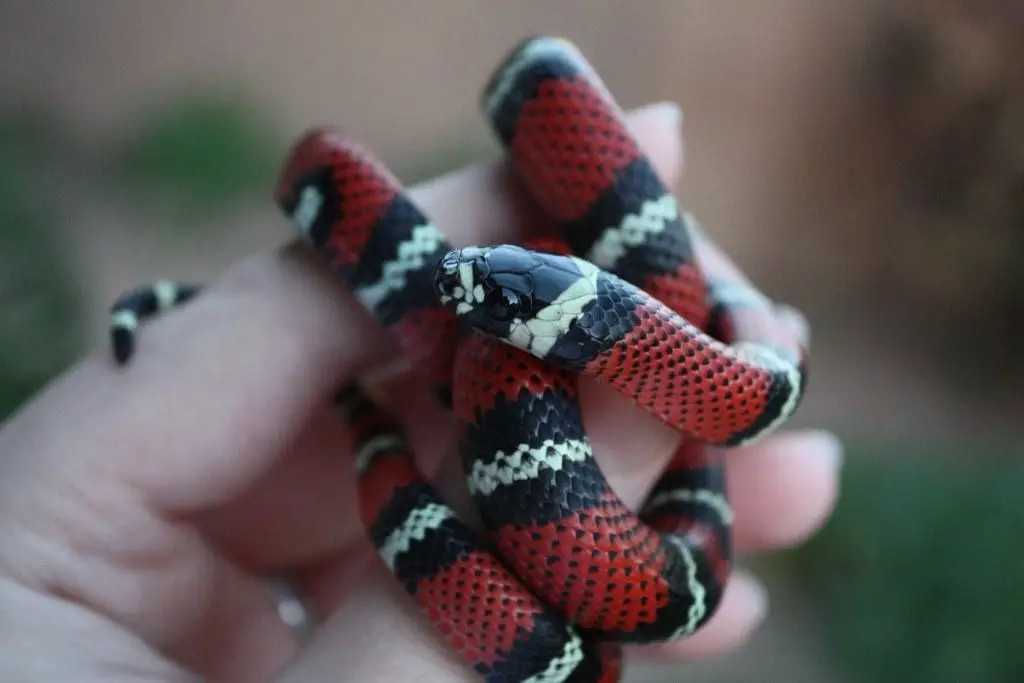
Black Milk Snakes are the only species in this family that shows a drastic color change. Even though many milkshakes develop some black tips along with age, black milk snakes turn into solid black. From time to time, you can see an adult snake retaining some faint bands, but most will be solid black, with some brownish parts under their chin.
There is no clear explanation of why the color of the Black Milk Snakes changes. However, a common theory is available. When they are still hatchlings, these snakes tend to mimic the venomous coral snakes in terms of appearance. They do so as a defense mechanism. As they get older, however, the conditions in the environment, along with the bulk of the snakes require a change.
Black Milk Snakes retain heat, thus allowing the bigger adults to warm up to the right temperatures for good health and digestion in the cool, cloudy, and montane habitats where they live.
Breeding in Captivity
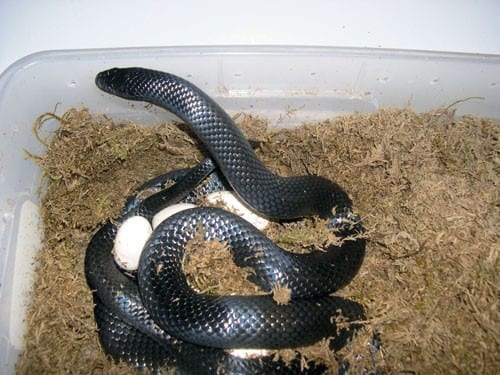
Before starting to breed your snakes, there are some things that need to be taken into consideration. For one, they should be old enough and of the right size. Usually, female black snakes are not yet ready until they are in their fourth year. Waiting until they turn 5 is even better. Waiting for the right time will result in better breeding, bigger hatchlings, and more eggs. The breeding females also need to be at least 5 feet in length as well.
Avoid disturbing your snakes in wintertime. Check the water bowls, replacing and cleaning as necessary. Monitor the temperature of the housing too. Start warming your snakes gradually by preparing a basking spot for about 2 hours every day. Turn on the lighting inside the cage for eight hours in the daytime. If you do not have lighting inside, prepare a room light on a timer.
Around mid-March, the ambient temperature needs to be a few degrees below the usual levels during summer. At this point, start feeding your snakes. These snakes start showing breeding activities right after their first shed after the winter cool-down. Usually, breeding occurs after the second shed cycle. At times, it may take three shed cycles.
After the female snake sheds during the breeding season, you can start placing your male snake into the cage. If the male snake gives a chase, and the female allows him to lock up, then it’s good. Most breeders usually give them about a couple of hours together, to attempt breeding. At times, doing so overnight is also good. Afterward, you can remove the male snake.
Wait for about three days before you attempt another breeding to happen. This is regardless of whether a successful lock-up is observed or not. You may want to allow your snakes to breed for about 4 or 5 times in this period. Due to the bulk of a Black Milk Snake, it is usually difficult to determine when a female is already swollen with eggs, or when the female is still ovulating.
To check whether the female snake is already carrying eggs, you can gently run your fingers along its belly. To ensure safety, you can prepare a moist hide box inside the cage all the time so that you will not miss the eggs. Most often, a sure sign that your snake is ready to lay a clutch of eggs is that she will refuse to eat after a shed. This will be around her third shed and is the pre-egg-laying shed.
Reproduction
Black Milk Snakes are considered as oviparous, which means that they lay eggs. The mating season usually happens from March or early days of May to late June. The actual date depends on the geographic range and subspecies.
The clutch size may number from 6 to 18 eggs. The average count, however, is 8 to 10 eggs. Typically, the eggs will be laid around 10 to 16 days after the pre-egg-laying-shed. At this point, avoid disturbing the female snake as she is preparing to lay. It is also important that the snake feels that her site for laying is safe and secure. Disturbing the female snake while laying may result in egg retention, which may be dangerous, even fatal, to the snake.
Once the eggs have already been laid, it will usually take the entire day to finish. When done, remove the female carefully from the hide box, and slowly place the eggs in the same position when they were laid, inside an incubation box filled with moistened vermiculite.
Close the box up, ensuring that the box is ventilated using a dozen or more holes in the side. This will help in preventing excess moisture from possibly building up and dripping on the eggs. Incubate the eggs at a temperature of 78 to 82 degrees Fahrenheit for about 65 to 75 days.
You may start lowering the temperatures during incubation in order to increase the incubation time. Take note that higher temperatures may result in snake deformities or even death of the embryo. Hatchlings may be kept inside commercial racks, with small cages. Prepare to undertake heating for a specific area to be warm, while the rest of the cage can have a temperature of 68 to 72 degrees Fahrenheit.
These snakes usually start breeding as soon as they leave brumation, even though they may mate at times in their winter dens. The female snakes leave a pheromone trail once they start to ovulate, allowing males to follow and find them.
The actual copulation may last for several hours, possibly to stop other males from mating with the ovulating female snake. Once the eggs are laid, there is no expected parental care that is provided to the hatchlings.
Where to Get Black Milk Snakes?
These snakes can be sourced from local breeders as well as from online sources. When ordering from an online breeder, it is recommended to buy only from a reputed source. After all, you surely would not want to compromise the quality of your hatchlings.
Conservation and Threat
Most subspecies of Milk Snakes are not protected federally or listed under the threatened list of the International Union for Conservation of Nature (IUCN). However, they are protected locally in certain states. In Georgia and Montana, though, they are listed under “species of concern.”
FAQs
Are Black Milk Snakes dangerous?
Milk snakes, in general, are usually confused with other dangerous snakes, including coral snakes and copperheads. Reality is, however, that milk snakes pose no real threat to humans. As a matter of fact, they are quite popular as pets because they can be bred easily in captivity.
How do you take care of a Black Milk Snake?
To take care of your Black Milk Snake pet, a tank that is about 24 inches in length and 16 inches in height is the recommended size. This will give your pet plenty of room space to move around. They also love soaking in water, which means that a heavy dish of clean water inside the tank is good for them. Make sure that the water is changed every day.
Are Black Milk Snakes friendly?
The Milk Snakes species, including Black Milk Snakes, are a popular option for pets. They are usually small enough to be caged in a standard-sized cage, and large enough to be attractive as pets to most snake enthusiasts. They do well in captivity and survive by eating thawed/frozen rodents regularly.
Why are Milk Snakes called as such?
Milk snakes got their name because it was once believed by people that reptiles suck milk from cow udders. This behavior is impossible anatomically for the snakes, as they do not have lips, and would not also be tolerated by cows.
Do Black Milk Snakes bite humans?
Even though it is most unlikely for black milk snakes to attack humans, they may bite for a reason. However, their bites are non-venomous. They will not cause so much damage, aside from surprising you as you find them. They can even be beneficial to humans because they eat animals that are considered as destructive to the environment, such as rodents.
What is the difference between Black Milk Snakes and King Snakes?
Every Black Milk Snake is a King Snake. However, not all King Snakes are Black Milk Snakes. Milk snakes are a subspecies of King Snakes.
Do Black Milk Snakes need a heat lamp?
Black Milk Snakes, just like all other subspecies of Milk Snakes, do not need a light, or a heat lamp. If you opt to add a basking bulb in order to introduce more lamp to your enclosure, make sure that you can keep the right heat levels while not going above 88 degrees Fahrenheit. This could be dangerous to the health of your snake.
Are Black Milk Snakes ideal for beginners?
Black Milk Snakes are very easy to take care of as a pet. They only grow to a small to medium-sized and are non-venomous, constrictor snakes. They need an enclosure with appropriate light and heating at a specific temperature and humidity that depends on their subspecies. They can be somewhat challenging to handle because they view humans as threats, though their bites do not really hurt.
Do Black Milk Snakes need UVB light?
The ideal temperature for Black Milk snakes are at 75 to 82 degrees Fahrenheit on the cooler side, and up to 80 to 85 degrees Fahrenheit on the warm side. Even though Black Milk Snakes do not require UVB in order to survive, both UVA and UVB light has been observed to improve their immune system greatly.
What will happen if a Black Milk Snake bites you?
The temperament of Black Milk Snakes is non-aggressive, which means that they do not pose risks to humans. They have small and hooked teeth instead of fangs. Even though their bite may hurt, getting bitten by these snakes would not really cause any serious harm.
How big do Black Milk Snakes get?
Adult Black Milk Snakes grow into an average of 48 to 76 inches. However, some have been observed to grow up to 7 feet in length.
Do Black Milk Snakes eat other snakes?
Generally, Black Milk Snakes are carnivorous. Adult snakes usually feed on rodents, including white-footed mice, voles, as well as house mice. They can also eat birds and their eggs, snake eggs, snake eggs, as well as other snakes, such as other venomous species like rattlesnakes and coral snakes.
How fast do Black Milk Snakes grow?
Most Black Milk Snakes grow up to 84 inches (213 cm). It usually takes a snake about 3 to 4 years to attain its full length.
Do Black Milk snakes eat worms?
Young Black Milk snakes usually eat insects, slugs, crickets, as well as earthworms. Adults, however, have a different diet, which usually includes lizards, particularly skinks, as well as smaller mammals. They can also eat birds and eggs, fish, frogs, as well as other snakes.
Are Black Milk Snakes arboreal?
Black Milk Snakes are considered as crepuscular, meaning that they are usually active at dawn and dusk. They are observed as ground dwellers and are also semi-arboreal, which means that they will climb trees.
How long do Black Milk Snakes live?
The lifespan of a Black Milk Snake is about 10 to 12 years. In order to help them live longer, it is important to give them a day and night photoperiod. Usually, a light schedule of 12 hours on and 12 hours off is ideal.
What is the habitat of a Black Milk Snake?
Black Milk Snakes are known to thrive in a wide range of habitats. They are typically found nearby forest edges and are also found in prairies and grasslands, open woodlands, near rivers and streams, rocky hillsides, as well as farmlands and suburban areas.

